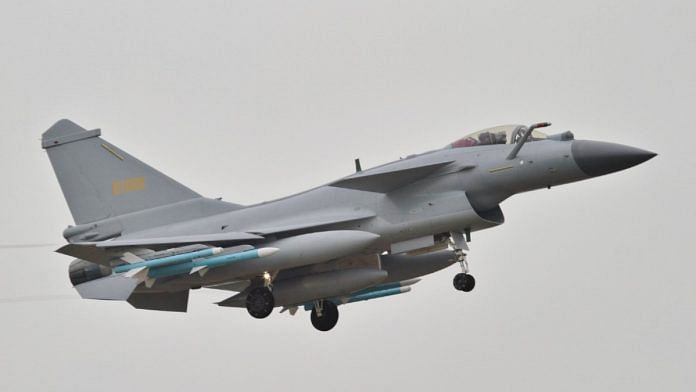New Delhi: Pakistan is reportedly in the process of inducting 25 Israel-inspired J-10C fighter jets from China by March this year, a move which is being touted as a response to India’s acquisition of 36 Rafale fighters.
The announcement was made by the country’s Interior Minister Sheikh Rasheed Ahmed at a public event in Rawalpindi last week. Speaking at the event, the minister said the Pakistan Air Force will do a fly past with “25 J-10s” on 23 March, on the occasion of Pakistan Day, a celebration similar to India’s Republic Day.
The figure of 25 is puzzling because a squadron has 18 fighters, sources in the defence establishment said, adding that it is most likely that some of these fighters will be used for further research and integration by the Pakistan Aeronautical Complex and with the country’s combat training school.
Also, while Rasheed Ahmed said 25 aircraft will do fly-past and the acquisition is a counter to India’s Rafale, there is a possibility that Pakistan may actually be getting more.
While it is not yet clear if Pakistan is actually buying the fighters, which have been in service with the People’s Liberation Army Air Force (PLAAF) since early 2000s, or getting them on loan from China, aviation experts and sources said that the J-10C, which is the latest variant, cannot be compared to the Rafale.
Also read: New IAF chief looks beyond 36 additional Rafale jets, wants 114 multi role fighter aircraft
Why J-10C and Rafale are different
Comparison between J-10C and Rafale is not possible, primarily because the latter is a twin-engined fighter with a globally recognised missile system and the latest electronic warfare suite.
The J-10C, which Pakistan has been eyeing for long, is actually a single engine fighter, which is in a different league than the Rafale. The design and inspiration for the J-10C comes from a junked Israeli fighter programme of the 1980s, defence sources explained.
“The main issue with the J-10C is the engine, which is having issues. They were using Russian engines and are now using their own developed engine. The other issue is with the AESA radar, a technology which the Western world has mastered and China is yet to,” Air Marshal Anil Chopra (retd), director of the think tank, Centre for Air Power Studies, told ThePrint.
He added that the J-10C cannot be compared to the Rafale as both are of different class in terms of weight and weaponry.
“The main air-to-air missiles of J-10C are the PL-15 Beyond Visual Range (BVR) missile, whose range is known only by what China claims,” he said.
The Chinese claim that the PL-15 has a range of about 140-150 kilometres, which is actually similar to that of the Meteor on the Rafale, which has been tested and is recognised, unlike the former.
Chopra also said the electronic warfare suite on the Rafale is the latest and cannot be compared to Chinese technology, which has not been tested in an actual warfare scenario.
Also read: Behind IAF’s new deal for Mirage 2000 spares is a 40-year saga of missed opportunities
The Israeli connection
It is believed that the J-10C traces its origin to Israel’s multi-billion dollar Lavi fighter jet programme which was halted in August 1987.
“J-10 draws its origin from the Israeli Lavi fighter programme which evolved from the F-16 fighters. The Israeli Air Force abandoned it in the late 1980s and the Chinese took that up and certain design changes were made,” Air Marshal Chopra said.
Incidentally, in 1988, then-Israeli defence minister Yitzhak Rabin had denied a Sunday Times of London report which claimed Israel and China were working together on missiles and fighter jet programmes.
At that time, China and Israel did not have diplomatic ties, but business was still carried out.
The report had claimed that Israel had agreed to sell advanced missile technology to China, and to help it develop a fighter plane using technology derived from the Lavi.
The National Interest has reported that one notable Israeli export from the Lavi programme to China was the Python-3 heat-seeking missile, which was licenced for production by China’s Xi’an Aircraft Corporation in 1989 as the PL-8 missile, which remains in service even today.
“In fact, during the 1980s, the US and Western Europe were also exporting military technology to China, then seen as a counter-balance to the Soviet Union. US firms even explored co-developing updated J-7 and J-8 fighters for Beijing. However, Chinese-Western defence cooperation ended abruptly following the Tiananmen Square massacre on 4 June 1989,” the National Interest report added.
Defence sources explained that while China and Israel had teamed up, Tel Aviv stopped under US pressure later, and Beijing went ahead independently with the fighter programme.
(Edited by Poulomi Banerjee)
Also read: Eye on mega deal with Navy, Dassault will fly Rafale Marine to India in 2022 for showcase trip



